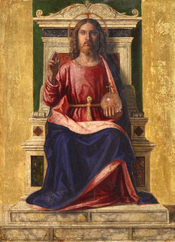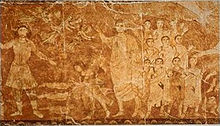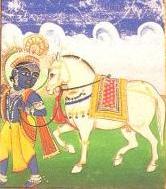
The afterlife or life after death is a purported existence in which the essential part of an individual's stream of consciousness or identity continues to exist after the death of their physical body. The surviving essential aspect varies between belief systems; it may be some partial element, or the entire soul or spirit, which carries with it one's personal identity.

Eschatology concerns expectations of the end of the present age, human history, or the world itself. The end of the world or end times is predicted by several world religions, which teach that negative world events will reach a climax. Belief that the end of the world is imminent is known as apocalypticism, and over time has been held both by members of mainstream religions and by doomsday cults. In the context of mysticism, the term refers metaphorically to the end of ordinary reality and to reunion with the divine. Religions treat eschatology as a future event prophesied in sacred texts or in folklore. While other religions may have concepts of renewal or transformation after significant events, the explicit description of a new earth is primarily found in Christian teachings within the context of eschatology, this description can be found in Chapter 21 of the Book of Revelation.

Heaven, or the heavens, is a common religious cosmological or transcendent supernatural place where beings such as deities, angels, souls, saints, or venerated ancestors are said to originate, be enthroned, or reside. According to the beliefs of some religions, heavenly beings can descend to Earth or incarnate and earthly beings can ascend to Heaven in the afterlife or, in exceptional cases, enter Heaven without dying.
Islamic eschatology is a field of study in Islam concerning future events that would happen in the end times. It is primarily based on sources from the Quran and Sunnah. Aspects from this field of study include the signs of the final age, the destruction of the universe and Judgement Day.

Jewish eschatology is the area of Jewish theology concerned with events that will happen in the end of days and related concepts. This includes the ingathering of the exiled diaspora, the coming of the Jewish Messiah, the afterlife, and the resurrection of the dead. In Judaism, the end times are usually called the "end of days", a phrase that appears several times in the Tanakh.
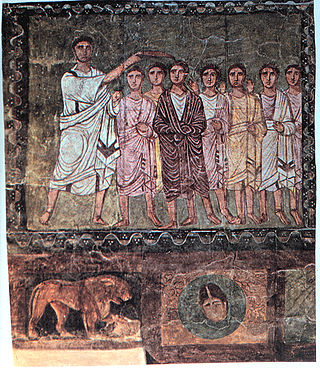
In Abrahamic religions, a messiah or messias is a saviour or liberator of a group of people. The concepts of mashiach, messianism, and of a Messianic Age originated in Judaism, and in the Hebrew Bible, in which a mashiach is a king or High Priest traditionally anointed with holy anointing oil.

In religion, paradise is a place of exceptional happiness and delight. Paradisiacal notions are often laden with pastoral imagery, and may be cosmogonical or eschatological or both, often compared with the miseries of human civilization: in paradise there is only peace, prosperity, and happiness. Paradise is a place of contentment, a land of luxury and fulfillment containing ever-lasting bliss. Paradise is often described as a "higher place", the holiest place, in contrast to this world, or underworlds such as Hell.

Kalki, also called Kalkin, is the prophesied tenth and final incarnation of the god Vishnu. He is described to appear in order to end the Kali Yuga, one of the four periods in the endless cycle of existence (Krita) in Vaishnava cosmology. The end of the Kali Yuga states this will usher in the new epoch of Satya Yuga in the cycle of existence, until the Mahapralaya.
Kali Yuga, in Hinduism, is the fourth, shortest and worst of the four yugas in a Yuga Cycle, preceded by Dvapara Yuga and followed by the next cycle's Krita (Satya) Yuga. It is believed to be the present age, which is full of conflict and sin.
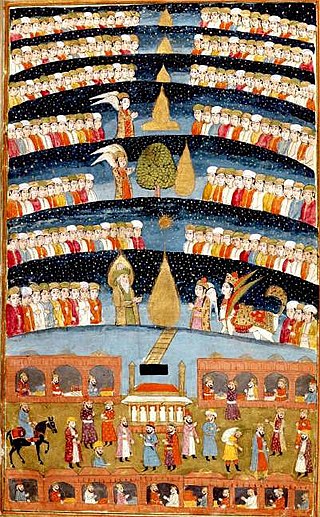
In Islam, Jannah is the final abode of the righteous. According to one count, the word appears 147 times in the Qur'an. Belief in the afterlife is one of the six articles of faith in Sunni and Twelver Shi'ism and is a place in which "believers" (Mumin) will enjoy pleasure, while the unbelievers (Kafir) will suffer in Jahannam. Both Jannah and Jahannam are believed to have several levels. In the case of Jannah, the higher levels are more desirable, and in the case of Jahannam, the lower levels have a higher level of punishments. — in Jannah the higher the prestige and pleasure, in Jahannam the severity of the suffering. The afterlife experiences are described as physical, psychic and spiritual.
Messianism is the belief in the advent of a messiah who acts as the savior of a group of people. Messianism originated as a Zoroastrian religious belief and followed to Abrahamic religions, but other religions also have messianism-related concepts. Religions with a messiah concept include Hinduism (Kalki) Judaism (Mashiach), Christianity (Christ), Islam, Druze faith, Zoroastrianism (Saoshyant), Buddhism (Maitreya), Taoism, and Bábism.
Hindu eschatology is linked in the Hindu tradition to the figure of Kalki, or the tenth and last avatar of Vishnu names of the Supreme Being in Hinduism and before the age draws to a close, and Harihara simultaneously dissolves and regenerates the universe.
In Abrahamic religions, the Messianic Age is the future period of time on Earth in which the messiah will reign and bring universal peace and brotherhood, without any evil. Many believe that there will be such an age; some refer to it as the consummate "kingdom of God" or the "world to come". Jews believe that such a figure is yet to come, while Christians and Muslims believe that this figure is Jesus Christ.

Adam is the name given in Genesis 1-5 to the first human. Adam is the first human-being aware of God, and features as such in various belief systems.
The Kalki Purana is a Vaishnava Hindu text about the tenth avatar of Vishnu named Kalki. The Sanskrit text was likely composed in Bengal during an era when the region was being ruled by the Bengal Sultanate or the Mughal Empire. Wendy Doniger dates it to sometime between 1500 AD and 1700 AD. It has a floruit of 1726 AD based on a manuscript discovered in Dhaka, Bangladesh.
Shamayim is the dwelling place of God and other heavenly beings according to the Bible. It is one of three components of the biblical cosmology. There are two other ones. Eretz (Earth), home of the living, and sheol, the realm of the dead—including, according to post Hebrew-Bible literature, the abode of the righteous dead.

Frashokereti is the Avestan language term for the Zoroastrian doctrine of a final renovation of the universe, when evil will be destroyed, and everything else will be then in perfect unity with God.
A Yuga Cycle is a cyclic age (epoch) in Hindu cosmology. Each cycle lasts for 4,320,000 years and repeats four yugas : Krita (Satya) Yuga, Treta Yuga, Dvapara Yuga, and Kali Yuga.
In Islam, "the promise and threat" of Judgement Day, is when "all bodies will be resurrected" from the dead, and "all people" are "called to account" for their deeds and their faith during their life on Earth. It has been called "the dominant message" of the holy book of Islam, the Quran, and resurrection and judgement the two themes "central to the understanding of Islamic eschatology." Judgement Day is considered a fundamental tenet of faith by all Muslims, and one of the six articles of Islamic faith.
